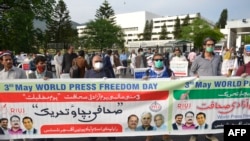In late May, Pakistan’s government proposed a law to create a new Pakistan Media Development Authority (PMDA) to oversee broadcast, print and all digital media.
According to the Dawn newspaper, the authority would have the right to “register digital media platforms, monitor and analyze them and ensure the enforcement of cyber laws.”
The government claims the centralized regulator will fix a “fractured” multiagency system that exists now. But prominent broadcasters, including the All Pakistan Newspapers Authority and the Pakistan Broadcasters Association, see it differently.
In a joint statement, the groups called the proposal “draconian” and said it would open the door to editorial pressure and potentially steep fines from the government.
In response, Minister of State for Information and Broadcasting, Farrukh Habib, said on August 18: “There will be no restriction on media freedom” under the new authority.
That statement is misleading.
As proposed, all forms of media would have to be licensed annually. The new, 10-member PMDA council would have the power to bar publication of content deemed false or that may incite violence or hatred. Officials could demand any documents they want and impound media property with impunity.
Media would have to abide by an official code of conduct, and fines as high as $1.5 million are authorized. Reviewing the PMDA proposal in South Asian Voices, Fizza Batool, a Ph.D. candidate at the University of Karachi, wrote:
“Non-adherence to the code of conduct—which is yet to be drafted by PMDA—could result in severe consequences including three to five years of imprisonment and fines worth millions of rupees. PMDA could also suspend a media outlet, summon the content producer for an explanation, and penalize media channels without warning or offering an opportunity for a hearing.
“The ordinance suggests forming media complaint councils that would hear public complaints against the media. The decisions of the councils and the authority can only be challenged before a media tribunal that oversees issues related to professional problems of media personnel. Furthermore, the only way to challenge the decision of the tribunal is through the Supreme Court of Pakistan.”
Critics say this new law would worsen conditions that are already bad under the current Pakistan Electronic Media Regulatory Authority (PEMRA), which has a history of suppression.
In 2018, for example, PEMRA warned media houses not to report “excessively on topics such as violence, kidnapping, sexual abuse, terrorism and natural disasters,” as part of an effort to counter Pakistan’s “negative” image.
Last year, PEMRA indefinitely suspended 24NewsHD, an outlet critical of the government, for “illegal transmission” of content.
Press freedom groups and journalists said the move aimed to suppress coverage of Pakistan’s opposition political parties.
The overall environment has been worsening for Pakistan’s journalists, who have frequently been harassed and assaulted.
Asad Ali Toor, who works at Aaj TV and hosts the YouTube channel “Asad Toor Uncensored,” faced sedition charges for criticizing state institutions on social media.
In May, Toor was attacked by three unidentified men who took his electronic devices.
A week later, he was summoned by Pakistan’s National Response Centre for Cyber Crime and accused of “defaming” Pakistan’s government. Exactly why was never explained.
Last year, journalist Matiullah Jan was abducted by armed men and later dropped off on the outskirts of the capital, Islamabad.
The incident happened a day before Jan was to appear in court on contempt charges for comments critical of a Supreme Court verdict.
Jan is a vocal critic of the Pakistani government and claimed that the abduction was an attempt to intimidate him.
The advocacy group Reports Without Borders (RSF) has ranked Pakistan 145th out of 180 countries in its latest annual press freedom rating toward the bottom.
According to RSF, since Imran Khan became Prime Minister in 2018, the influence of Inter-Services Intelligence (ISI), Pakistan’s military intelligence agency, “which cannot stand independent journalism, has increased dramatically.” In addition to serving as head of state, Khan is chairman of the ruling party, Pakistan Tehreek-e-Insaf (PTI).
On August 23, Human Rights Watch, a non-governmental organization based in New York, condemned the proposed PMDA law, saying an independent body needs to be responsible for media regulation. The group said the government should “stop trying to control reporters and instead start protecting media freedom.”
While Minister for Information and Broadcasting Fawad Chaudhry recently lauded the legislation, the Pakistan Federal Union of Journalists (PFUJ) plans to protest outside the next session of parliament.





